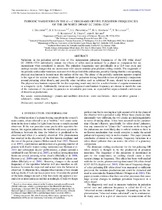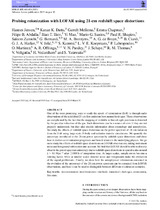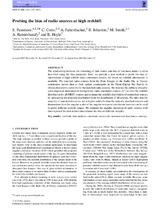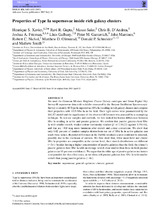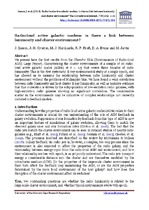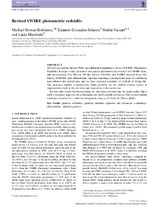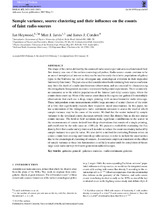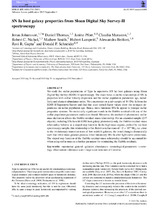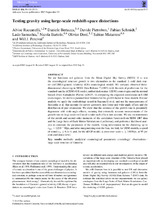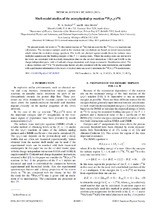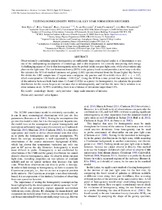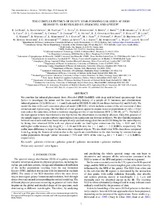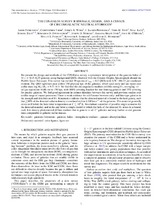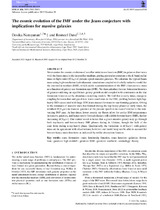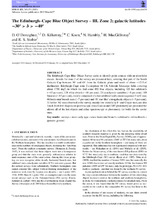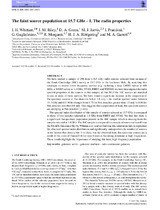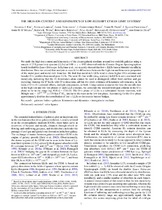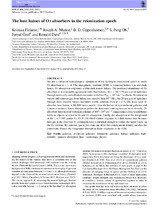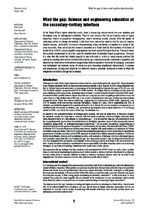Physics and Astronomy: Recent submissions
Now showing items 461-480 of 520
-
Periodic variations in the O-C diagrams of five pulsation frequencies of the DB white dwarf EC 20058-5234
(American Physical Society, 2013)Variations in the pulsation arrival time of five independent pulsation frequencies of the DB white dwarf EC 20058−5234 individually imitate the effects of reflex motion induced by a planet or companion but are inconsistent ... -
Probing reionization with LOFAR (Low Frequency Array) using 21-cm redshift space distortions
(Oxford University Press, 2013)One of the most promising ways to study the epoch of reionization (EoR) is through radio observations of the redshifted 21-cm line emission from neutral hydrogen. These observations are complicated by the fact that the ... -
Probing the bias of radio sources at high redshift
(Oxford University Press, 2013)The relationship between the clustering of dark matter and that of luminous matter is often described using the bias parameter. Here, we provide a new method to probe the bias of intermediate-to-high-redshift radio ... -
Properties of Type Ia supernovae inside rich galaxy clusters
(Oxford University Press, 2013)We used the Gaussian Mixture Brightest Cluster Galaxy catalogue and Sloan Digital Sky Survey-II supernovae data with redshifts measured by the Baryon Oscillation Spectroscopic Survey to identify 48 Type Ia supernovae ... -
Radio-loud active calactic nucleus: is there a link between luminosity and cluster environment?
(American Physical Society, 2013)We present here the first results from the Chandra ERA (Environments of Radio-loud AGN) Large Project, characterizing the cluster environments of a sample of 26 radio-loud active galactic nuclei (AGNs) at z ∼ 0.5 that ... -
Revised SWIRE photometric redshifts
(Oxford University Press, 2013)We have revised the Spitzer Wide-Area Infrared Extragalactic survey (SWIRE) Photometric Redshift Catalogue to take account of new optical photometry in several of the SWIRE areas, and incorporating Two Micron All Sky ... -
Sample variance, source clustering and their influence on the counts of faint radio sources
(Oxford University Press, 2013)The shape of the curves defined by the counts of radio sources per unit area as a function of their flux density was one of the earliest cosmological probes. Radio source counts continue to be an area of astrophysical ... -
SN Ia host galaxy properties from Sloan Digital Sky Survey-II spectroscopy
(Oxford University Press, 2013)We study the stellar populations of Type Ia supernova (SN Ia) host galaxies using Sloan Digital Sky Survey (SDSS)-II spectroscopy. The main focus is on the relationships of SN Ia properties with stellar velocity dispersion ... -
Stacked reverberation mapping
(Oxford University Press, 2013)Over the past 20 years reverberation mapping has proved one of the most successful techniques for studying the local (<1 pc) environment of supermassive black holes that drive active galactic nuclei. Key successes of ... -
Testing gravity using large-scale redshift-space distortions
(Oxford University Press, 2013)We use luminous red galaxies from the Sloan Digital Sky Survey (SDSS) II to test the cosmological structure growth in two alternatives to the standard cold dark matter ( CDM)+general relativity (GR) cosmological model. ... -
Shell-model studies of the astrophysical rp reaction 29P(p, y)30 S
(American Physical Society, 2013)We present results for levels in 30S (the mirror nucleus of 30Si) that are used for the 29P(p,γ ) rp reaction rate calculations. The resonance energies used in the reaction rate calculations are based on recent ... -
Testing homegeneity with Galaxy Star formation histories
(IOP Publishing, 2013)Observationally confirming spatial homogeneity on sufficiently large cosmological scales is of importance to test one of the underpinning assumptions of cosmology, and is also imperative for correctly interpreting dark ... -
The complex physics of dusty star-forming galaxies at high redshifts as revealed by Herschel and Spitzer
(IOP Publishing, 2013)We combine far-infrared photometry from Herschel (PEP/HerMES) with deep mid-infrared spectroscopy from Spitzer to investigate the nature and the mass assembly history of a sample of 31 luminous and ultraluminous infrared ... -
The COS-Halos survey: Rationale, design and a census of circumgalactic neutral hydrogen
(IOP Publishing, 2013)We present the design and methods of the COS-Halos survey, a systematic investigation of the gaseous halos of 44 z = 0.15–0.35 galaxies using background QSOs observed with the Cosmic Origins Spectrograph aboard the Hubble ... -
The cosmic evolution of the IMF under the Jeans conjecture with implications for massive galaxies
(Oxford University Press, 2013)We examine the cosmic evolution of a stellar initial mass function (IMF) in galaxies that varies with the Jeans mass in the interstellar medium, paying particular attention to the K-band stellar mass-to-light ratio (M/LK) ... -
The Edinburgh-Cape Blue Object Survey - III. Zone 2; galactic latitudes -30? > b > -40?
(Oxford University Press, 2013)The Edinburgh–Cape Blue Object Survey seeks to identify point sources with an ultraviolet excess. Results for zone 2 of the survey are presented here, covering that part of the South Galactic Cap between 30◦ and 40◦ from ... -
The faint source population at 15.7 GHz - I. The radio properties
(Oxford University Press, 2013)We have studied a sample of 296 faint (>0.5 mJy) radio sources selected from an area of the Tenth Cambridge (10C) survey at 15.7 GHz in the Lockman Hole. By matching this catalogue to several lower frequency surveys (e.g. ... -
The high-ion content and kinematics of low-redshift lyman limit systems
(The American Astronomical Society, 2013)We study the high-ion content and kinematics of the circumgalactic medium around low-redshift galaxies using a sample of 23 Lyman limit systems (LLSs) at 0.08 < z < 0.93 observed with the Cosmic Origins Spectrograph on ... -
The host haloes of O I absorbers in the reionization epoch
(Oxford University Press, 2013)We use a radiation hydrodynamic simulation of the hydrogen reionization epoch to study OI absorbers at z ∼ 6. The intergalactic medium (IGM) is reionized before it is enriched; hence, OI absorption originates within dark ... -
Mind the gap: Science and engineering education at the secondary–tertiary interface
(Academy of Science of South Africa, 2013)In the South African higher education sector, there is increasing concern about the poor retention and throughput rates of undergraduate students. There is also concern that the participation rates in higher education, ...

